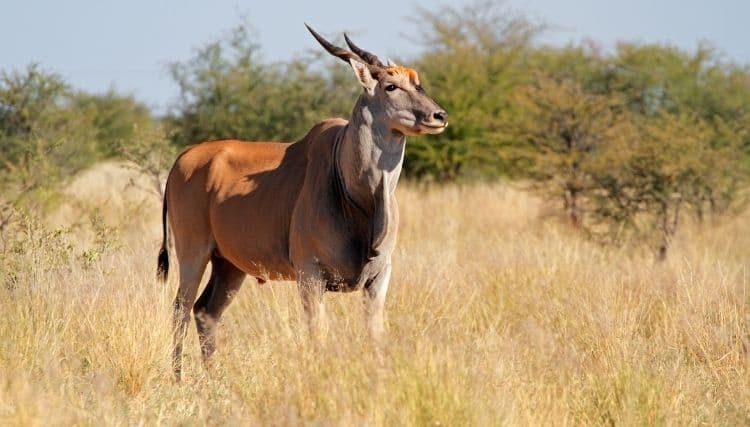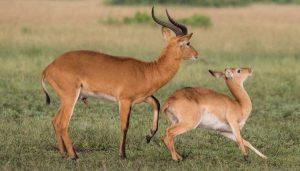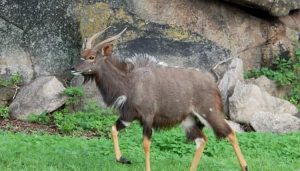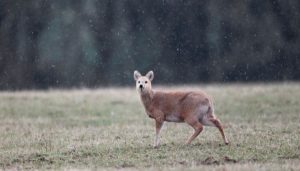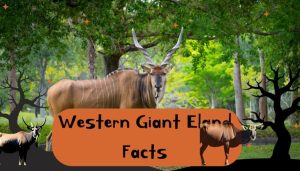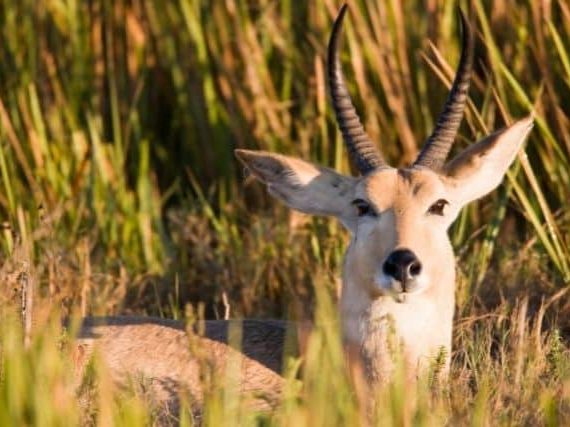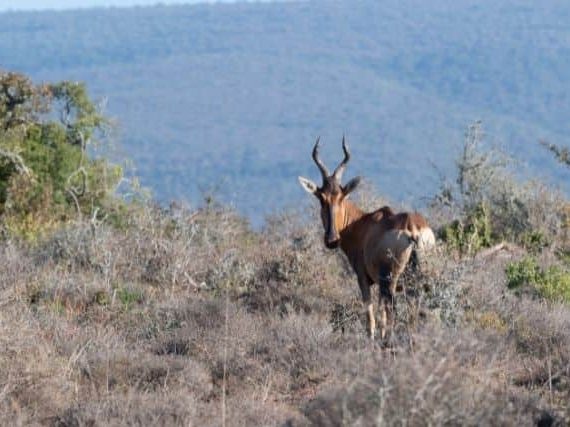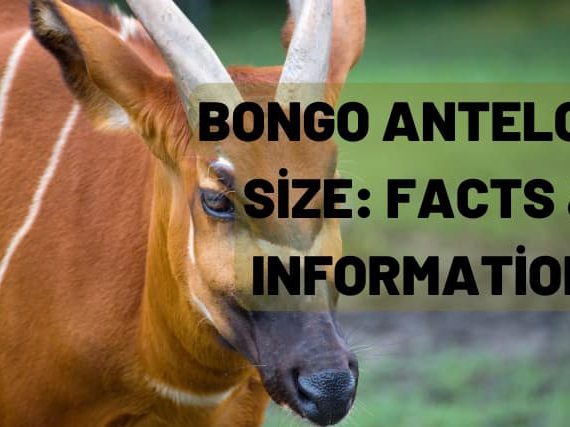Eastern giant eland antelopes are fascinating creatures that belong to the family Bovidae, which includes other herbivorous animals like domestic cattle. The scientific name for this species is Taurotragus derbianus. These majestic animals can grow up to 2.5 meters tall and weigh up to a whopping 900 kilograms.
One of the most interesting facts about Eastern giant elands is their diet. Studies have shown that these herbivores mainly consume grasses, but they also regularly intake fruits and other plant parts. Due to their large size and lack of natural predators, Eastern giant elands have relatively large home ranges and often form groups of up to 30 individuals.
Female Eastern giant elands have a gestation period of around nine months, with births typically occurring during the rainy season. Molecular phylogenetics studies suggest that this species is one of the oldest living antelope species.
It’s important to note that while these animals may not face many natural predators due to their size, they are still at risk from human activities such as habitat destruction and poaching. Conservation efforts are crucial in ensuring the survival of these magnificent creatures.
Physical Characteristics of the Giant Eland
Body Length of the Eastern Giant Eland Antelope
The eastern giant eland antelope is a majestic animal that can grow up to 3 meters long from head to tail. This makes them one of the largest antelopes in the world. Their elongated body allows them to move swiftly through the savannahs and forests where they live, making them an impressive sight for any nature enthusiast.
Their impressive size also contributes to their survival in the wild. As larger animals, they are less susceptible to predation than smaller animals. Their large size allows them to travel long distances in search of food and water without becoming fatigued easily.
Weight of the Eastern Giant Eland Antelope
Eastern giant eland antelopes are not only long but also heavy. They can weigh up to 1,000 kilograms or 2,200 pounds! This weight is necessary for their survival in their natural habitat because it provides insulation against cold temperatures at night and helps protect against predators.
Their weight also enables them to store energy reserves that allow them to survive during times when food is scarce. This adaptation has allowed eastern giant elands to thrive even in areas with harsh climates or limited resources.
Coat Color and Pattern
Eastern giant eland antelopes have a unique coat color that sets them apart from other species of antelopes. Their reddish-brown coat is marked by vertical white stripes on their torso, giving them a distinctive appearance that’s easy to recognize.
This coat pattern serves as camouflage, allowing eastern giant elands to blend into their surroundings and avoid detection by predators such as lions or hyenas. The vertical stripes also help break up their silhouette, making it difficult for predators to distinguish between individual animals within a herd.
Horns and Dewlap
Both male and female eastern giant eland antelopes have long spiral-shaped horns that can reach up to 1.5 meters (5 feet) in length. These horns are used for defense against predators and in territorial battles with other males during mating season.
In addition to their impressive horns, eastern giant elands also have a distinctive dewlap, which is a flap of skin hanging from their neck. This feature is more prominent in males than females and is thought to play a role in attracting mates during the breeding season.
Unique Traits of the Giant Eland
Western Giant Eland: The Largest Antelope in the World
Lurking in the savannas of Africa is a majestic creature known as the giant eland antelope. This magnificent animal is the largest species of antelope in the world, with the western giant eland being the largest subspecies. Here are some unique traits that make this animal stand out.
Long and Large Horns
Both male and female giant elands have long, spiral-shaped horns that can grow up to 4 feet long and are used for defense against predators and competition for mates. Young elands, including common eland calves, have small horns that grow as they mature. The size of their horns makes them not only an impressive sight but also a formidable opponent when it comes to defending themselves.
Large Ears and Powerful Legs
The giant eland’s large ears help them detect predators from a distance. Their powerful upper forelegs allow them to run at speeds of up to 40 miles per hour. These features make them agile enough to escape from predators such as lions, hyenas, or wild dogs.
Belongs to Tragelaphini Tribe
The giant eland belongs to the tribe Tragelaphini and the genus Tragelaphus, which also includes other savanna antelopes such as bushbuck and kudu. However, unlike its relatives, it has a unique appearance due to its massive size.
Threatened by Hunting
Unfortunately, these majestic creatures are threatened by hunting activities in some parts of Africa. They are hunted for their meat and trophy hunting purposes, leading to a decline in their population over time. Conservation efforts are underway across Africa to protect these animals from extinction.
The behavior of the Giant Eland
Giant elands are majestic animals that belong to the antelope family. They are known for their impressive size, striking appearance, and unique behavior. In this section, we will delve into some fascinating aspects of giant eland behavior.
Leading the Herd: The Lord Derby
Giant eland herds are usually led by a dominant male, known as the “lord derby” or “derbianus.” This male goat is responsible for protecting the herd from predators and other males. He also ensures that his herd has access to food and water sources. The lord derby is an imposing figure, with long spiraled horns that can grow up to 4 feet in length.
Mating Season
During the wet season, adult males will join the herd for mating. However, they will leave once the rainy season ends. The estrous cycle of female giant elands lasts for around 21 days, and suckling bouts with their young can last for up to 6 months. During this time, females become more aggressive towards males who try to approach them.
Seasonal Migration Patterns
Eastern giant elands are known for their seasonal migration patterns, which are influenced by changes in food availability and water sources. These migrations can cover hundreds of miles across different habitats such as savannas and forests.
Ritualistic Behavior During Mating Season
Lithuanian élnis, a subspecies of giant eland found in Eastern Europe, have been observed engaging in ritualistic behavior during mating season. This includes head-butting and vocalizations between males competing for females’ attention.
Giant Eland vs Common Eland: What’s the Difference?
Separate Groups: Giant Eland vs Common Eland
Giant eland and common eland are two different species of antelopes that belong to separate groups. While both species share some similarities, they also have distinct differences that set them apart.
Size Matters: Giant Eland is Larger
One of the most noticeable differences between giant eland and common eland is their size. As their name suggests, giant elands are larger than common elands. Giant elands can grow up to 6 feet tall at the shoulder and weigh over 2,000 pounds, while common elands typically reach a height of 5 feet at the shoulder and weigh around 1,200 pounds.
Distinct Stripes: Vertical vs Horizontal
Another distinguishing feature between giant eland and common eland is their stripes. Both species have white stripes on their torso, but the direction and pattern of these stripes differ. Giant elands have vertical white stripes that run down their sides, while common elands have more horizontal stripes that wrap around their bodies.
Habitat Range: Central vs Various Parts of Africa
The habitat range of giant eland is limited compared to that of common eland. Giant elands can be found in central and western Africa, particularly in countries such as Senegal, Mali, Niger, Burkina Faso, Ghana, Ivory Coast, Guinea-Bissau, and Cameroon. On the other hand, common elands can be found throughout various parts of Africa including southern Africa (Botswana), eastern Africa (Kenya), and western Africa (Senegal).
Where to Find Giant Elands in the Wild
Savannas and Grasslands of Central and West Africa
Eastern giant eland antelopes are majestic creatures that roam the savannas and grasslands of Central and West Africa. These animals can be found in countries such as Cameroon, Chad, Central African Republic, Congo, and Sudan. Eastern giant elands prefer areas with a mix of open grasslands and wooded areas. This is because they require both grazing and shelter.
The eastern giant Eland antelope is the largest species of antelope in the world. They stand at an average height of 6 feet at the shoulder and weigh between 900-1,800 pounds. Their long, spiral horns can grow up to four feet in length! Despite their size, these animals are incredibly agile and can run up to 40 miles per hour.
Habitat Preferences
Eastern giant elands are herbivores that primarily feed on grasses but also browse on leaves from trees or shrubs. They prefer areas with abundant vegetation where they can graze freely without having to travel too far for food. Elands are known for their ability to survive in harsh environments with limited water sources.
These antelopes prefer living near rivers or other water sources because they need to drink regularly. During the dry season when water is scarce, they will dig wells using their hooves to access groundwater.
Population Decline
Unfortunately, eastern giant eland populations have significantly declined due to habitat loss and hunting. These beautiful animals are now considered rare sightings in the wild.
In some parts of Africa, poaching remains a significant threat to eastern giant elands’ survival despite being protected by law. The demand for bushmeat has led many hunters to target these animals illegally. Commercial hunting has also been a contributing factor in population decline over recent years.
Threats to Giant Eland Population and Conservation Efforts
Livestock populations and human settlements are among the primary threats to the giant eland population. The encroachment of these factors on the giant eland’s natural habitat has led to habitat destruction and fragmentation, which have significantly impacted their population. As a result, the giant eland is listed as endangered or critically endangered across different countries by the International Union for Conservation of Nature.
Small herds and low population densities make the giant eland vulnerable to hunting and poaching. In some areas where they live, hunting is still a common practice, making it challenging to maintain their population levels. With small herds, there is an increased risk of inbreeding and genetic homogeneity that can lead to further declines in population.
Conservation efforts for the giant eland include captive breeding programs such as those at Bandia Reserve in Senegal. These programs aim to increase their numbers by breeding them in captivity before releasing them into protected areas. Protection of water sources and migration routes is another conservation measure that has been taken to ensure that these animals can thrive in their natural environment.
The life expectancy of juvenile giant elands is low due to predation and disease, which further threatens their population. Predators such as lions and hyenas prey on young calves while diseases like rinderpest have had a devastating effect on populations in South Sudan and Central African Republic.
Fun Facts about Giant Elands
Giant elands are magnificent creatures that inhabit the savannas and grasslands of Africa. These majestic antelopes are known for their impressive size, agility, and unique social structure. In this section, we will delve deeper into some fun facts about giant elands.
The Largest Antelope in the World
Giant elands are the largest antelopes in the world, with males weighing up to 1,000 kg and standing over 2 meters tall at the shoulder. They have a distinctive reddish-brown coat with vertical white stripes on their sides that help them blend into their surroundings. Females are slightly smaller than males but still impressively large.
Agile Runners
Despite their size, giant elands are incredibly agile and can run up to 70 km/h when threatened. This speed allows them to evade predators such as lions and hyenas that hunt them in packs. Giant elands also have long legs that enable them to leap over obstacles effortlessly.
Domesticated Ancestors
Common elands, which are smaller than giant elands, were domesticated by ancient Egyptians and used for their milk, meat, and hides. These animals were highly valued for their ability to provide food and materials for clothing and shelter. However, giant elands have never been successfully domesticated due to their size and wild nature.
Unique Social Structure
Giant elands have a unique social structure where females form groups with their young while males live alone or in bachelor groups until they are old enough to compete for a harem. The dominant male will mate with several females who will give birth to one calf per year. The calves remain with their mothers until they reach sexual maturity at around two years of age.
Pictures of Giant Elands in Their Natural Habitat

Where Does The Eastern Giant Eland Live?
Eastern giant elands are magnificent creatures that can be found in various habitats, including savannas, woodlands, and forests. These antelopes graze on a variety of plants such as grasses and leaves. Let’s take a closer look at these majestic animals and their natural habitat.
Male Elands: The Giants of the Savanna
Male eastern giant elands are known for their impressive size. They can grow up to 6 feet at the shoulder and weigh over 2,000 pounds. Their massive horns can reach up to four feet long and curve backward. These horns are used for self-defense against predators or during mating season when males compete for females’ attention.
Eland Herds: A Sight to Behold
Eland herds can consist of up to 500 individuals and have large home ranges that span national parks and rocky landscapes. These herds move around depending on food availability, water sources, and seasonal changes. During the dry season, eland herds gather near water sources like rivers or lakes.
Giant Eland Calves: Spotted Coats Provide Camouflage
Giant eland calves are born with a spotted coat that helps them blend in with their surroundings while protecting them from predators. After a few months, they lose their spots and develop a solid coat coloration similar to adult elands.
Conservation Efforts in Niokolo Koba National Park
Niokolo Koba National Park in Senegal is one of the few places where eastern giant elands can still be found in the wild, making it an important conservation area for this species. This park covers an area of over 9,000 square kilometers (3,475 square miles) and provides habitat for other wildlife species like lions, leopards, chimpanzees, and elephants among others.
Why We Must Protect the Giant Eland
The giant eland is a majestic creature that deserves our attention and protection. With its unique physical characteristics, behavior, and traits, it adds value to the biodiversity of our planet. However, the giant eland population is facing threats that could potentially lead to their extinction. This is why we must take action to protect these magnificent animals.
Giant elands are not just any other antelope species; they are the largest among them all. They possess distinctive spiral-shaped horns that can grow up to four feet long. Their coats have striking patterns of white stripes on a tan or reddish-brown background. These features make them a sight to behold in their natural habitat.
What sets giant elands apart from other antelopes is their unique traits such as their ability to leap high fences with ease and their keen sense of hearing and smell that helps them detect predators from a distance. They also have a special digestive system that allows them to eat tough vegetation other grazers cannot digest.
In terms of behavior, giant elands are social animals that live in herds led by dominant males. During mating season, males engage in impressive displays of dominance through clashing horns with each other.
While giant elands may seem similar to common elands at first glance, they differ significantly in size and habitat preference. Giant elands prefer forested areas while common elands thrive in open savannahs.
Unfortunately, human activities such as hunting for meat and trophy hunting, habitat destruction due to agriculture and logging activities, and disease outbreaks threaten the existence of giant eland populations across Africa. Conservation efforts such as establishing protected areas for these animals and enforcing anti-poaching laws are necessary if we want these majestic creatures to continue roaming freely in the wild.
- Western Giant Eland Antelope: The Largest Antelope in the World
- Common Eland Antilope: What You Need to Know
- Referans: Giant Eland
- Talk: Giant Eland
How High Can Eastern Giant Eland Antelope Jump?
It can jump up to 1.5 meters high and 3 meters long!
İs Eastern Giant Eland Antelope Aggressive?
The Eastern giant eland antelope is not aggressive towards humans. They are known to be very shy creatures and will run away from humans rather than attack them.
Can Eastern Giant Eland Antelope Swim?
It can swim in water for short distances but cannot do so for long periods due to its size and weight.
What Plants Do Eastern Giant Eland Antelope Avoid?
Eastern Giant Eland Antelope avoid plants with high levels of tannins, such as acacia trees and shrubs, due to their astringent taste.
Where Do Eastern Giant Eland Antelope Sleep?
Eastern giant eland antelopes often sleep close to water sources such as rivers or lakes to avoid dehydration during dry seasons. They also sleep near their food sources so they don’t have to travel far for food when they wake up.

